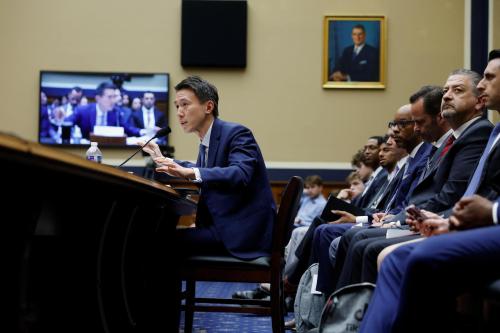This report is part of the Series on Financial Markets and Regulation and was produced by the Brookings Center on Regulation and Markets.
The global push toward centralized clearing of over-the-counter derivatives following the financial crisis has led to a new set of headaches for the financial system and the regulators that oversee it. The Wall Street Journal recently reported on one such problem—a shortage of safe assets driven in part by the demand by central clearinghouses. Another issue getting a lot of attention these days is recovery and resolution planning for these now too-big-to-ignore clearinghouses. While policymakers are to be commended for taking up the topic, their deliberations provide an unsettling preview of what we might face if a clearinghouse runs into trouble and government authorities jump in to help.
A key Dodd-Frank objective—justified in the name of financial stability—was the mandatory central clearing of standardized over-the-counter derivatives. Once a derivative contract is entered into, a central clearinghouse steps in to become the counterparty to both parties to the transaction. Because many derivatives contracts are long-lived, replacing the original counterparty with an ultra-safe clearinghouse removes nagging questions about counterparty creditworthiness.
Clearinghouses, which protect themselves with margin and a member-supplied guaranty fund, have a pretty good, but not impeccable, track record. One historical blemish—discussed in a recent webinar by the Federal Reserve Bank of Chicago’s Robert Cox—was the failure of the Hong Kong Futures Exchange clearinghouse in 1987. After initial hesitation, the Hong Kong government intervened to save it and stem the market turmoil the clearinghouse failure had caused.
Dodd-Frank provides for close regulatory oversight of clearinghouses by the Commodity Futures Trading Commission (CFTC), the Securities and Exchange Commission (SEC), and the Federal Reserve. But the statute is hazy on what might happen if risk managers at the clearinghouses and their regulators drop the ball. Under Title VIII of Dodd-Frank, as law professor Colleen Baker has detailed, clearinghouses that have been designated as systemically important can borrow from the Fed in emergencies. And some, including the Federal Deposit Insurance Corporation (FDIC), argue that Dodd-Frank’s Title II resolution authority allows the FDIC to resolve failing clearinghouses. Others, such as Professor Stephen Lubben, argue that the statute does not contemplate clearinghouse resolutions. If the FDIC is right that Dodd-Frank gives a bank regulator that lacks clearing expertise and supervisory experience the job of resolving failing clearinghouses, this charge reflects a lack of appreciation for the difficult issues involved in such an exercise.
Clearing members—a handful of the largest financial firms in the world—do appreciate the complexities and have been pushing clearinghouses and regulators to take up recovery and resolution in earnest. Clearing members have significant amounts of their own and their clients’ money tied up at clearinghouses and are likely to be asked for more money if a clearinghouse runs into trouble. Understanding their exposures to clearinghouses is key to managing their own risk and calculating their capital requirements.
One likely source of trouble at a clearinghouse is a defaulting member. When a member fails to meet its obligations, the clearinghouse springs into action to wind down the defaulter’s portfolio and return the clearinghouse to a balanced book where each position is matched by an equal, offsetting position. Clearinghouse default waterfalls set out the basic roadmap for how any losses are allocated. The typical waterfall absorbs those losses first with the failing member’s margin contributions, then with its guaranty fund contribution, then perhaps with some of the clearinghouse’s own (i.e. its shareholders’) money, and finally with the non-defaulting members’ guaranty fund contributions.
It is very unlikely that all of these sources would be consumed by a single member default, but what if multiple members were to default? Or, what if the clearinghouse incurs large losses because of an operational or investment failure by, or cyberattack on, the clearinghouse? What if the defaulting clearing member is also a major source of liquidity for the clearinghouse?
U.S. and global regulators are focusing on these issues. The CFTC staff issued guidance last July to clearinghouses for resolution and recovery planning. International regulators issued guidance on the subject in 2014. In February of this year, the Financial Stability Board (FSB) asked for comment on proposed clearinghouse resolution guidance for governments.
These documents reveal regulatory appreciation for the complexity of managing clearinghouse risk and the need for transparency. For example, the CFTC staff identifies 13 factors that clearinghouses should analyze with respect to at least eight potential risk scenarios. These analyses look at which recovery tools the clearinghouse will use (such as asking members to provide additional funds, haircutting the margin owed to members, or tearing-up contracts to return to a matched book); how and when it will use those tools; and what the adverse consequences to clearing members, their clients, and the rest of the financial system will be. And the 2014 international guidance calls for transparency with regard to how such tools are used to “allow those who would bear losses and liquidity shortfalls to measure, manage, and control their potential exposure.”
While regulators strive to bring predictability and transparency to the complexity of clearinghouse risk management, they are adding their own measure of unpredictability around whether, when, and how the government will intervene. As Stanford Professor Darrell Duffie explains: “A key policy question is when to interrupt a contractually based [clearinghouse] default management process with an overriding failure resolution process . . . .” He argues for “transparent and predictable” resolution procedures.
The FSB’s proposed guidance offers substantial latitude to government resolution authorities on when to intervene and what steps to take when they do. The proposed directive suggests that the determination of whether to place a clearinghouse in a government resolution process “should take into account the particular circumstances . . . and a broad range of factors,” such as whether the resolution option comes with access to government funds and clearinghouse members’ lack of confidence in the clearinghouse. This “amorphous facts-and-circumstances approach”—as attorney Bob Zwirb called it—does not provide the certainty that financial market participants need.
Moreover, in contrast to clearly specified default management protocols demanded of clearinghouses, regulators’ own procedures are difficult to pin down. In a June 2016 presentation, staff of the CFTC and FDIC laid out a list of powers that might be exercised in a government resolution without offering the same kind of constraints that the CFTC guidance prescribes for clearinghouses.
In any event, the possibility that the FDIC—not one of the regulators charged with daily oversight of clearinghouses—will take over during a crisis adds a further measure of uncertainty for clearinghouses and the firms that use them. The FDIC’s experience in resolving banks does not translate well into running a troubled clearinghouse. Even managing a single member default while keeping the clearinghouse up and running requires specific expertise and quick decision-making, as it involves hedging the defaulter’s portfolio, auctioning off the defaulter’s positions, and transferring its client positions to other clearing members. Managing a more severe situation that entails allocating losses to surviving clearing members would be even more difficult. These are not tasks for which the FDIC is prepared, and the entrance of the FDIC—unbounded by the clearinghouse’s crisis-management plans—could impede member cooperation, which is essential in successfully managing a clearinghouse crisis.
Rather than raising the prospect of government intervention and all of the uncertainties such intervention would bring, regulators should concentrate their efforts on assisting clearinghouses to develop workable, transparent plans of their own. As Federal Reserve Governor Jerome Powell warned, “To ensure that CCPs do not themselves become too-big-to-fail entities, we need transparent, actionable, and effective plans for dealing with financial shocks that do not leave either an explicit or implicit role for the government.” Removing the prospect of government intervention—including by clarifying that Title II resolution is not an option—will help clearinghouses, their members, and other entities that use or interact with the clearinghouse to plan.
Today’s clearinghouses hold a complicated, diverse set of products and are heavily interconnected with one another and with a handful of major financial firms. Planning for distress is wise. Hinting that a regulator like the FDIC might take over, or that the Fed might come to the rescue when the going gets rough, is not wise. After all, clearinghouses have a successful history of bringing market participants together to work out their own problems.
The authors did not receive financial support from any firm or person for this article or from any firm or person with a financial or political interest in this article. They are currently not an officer, director, or board member of any organization with an interest in this article.









